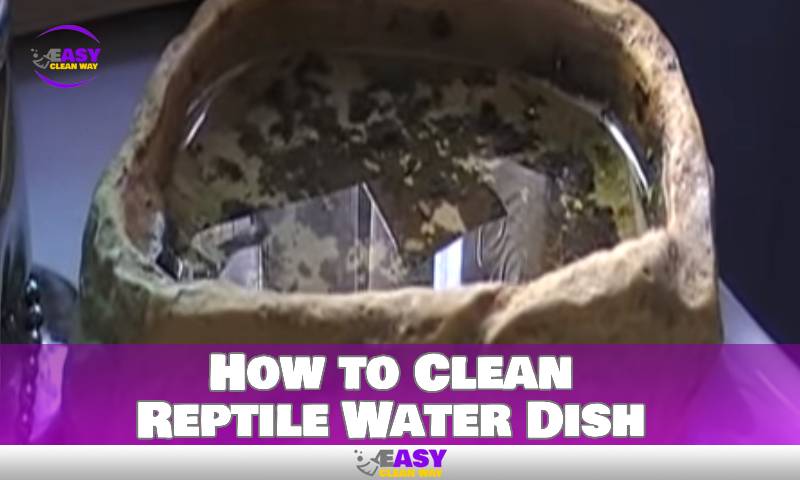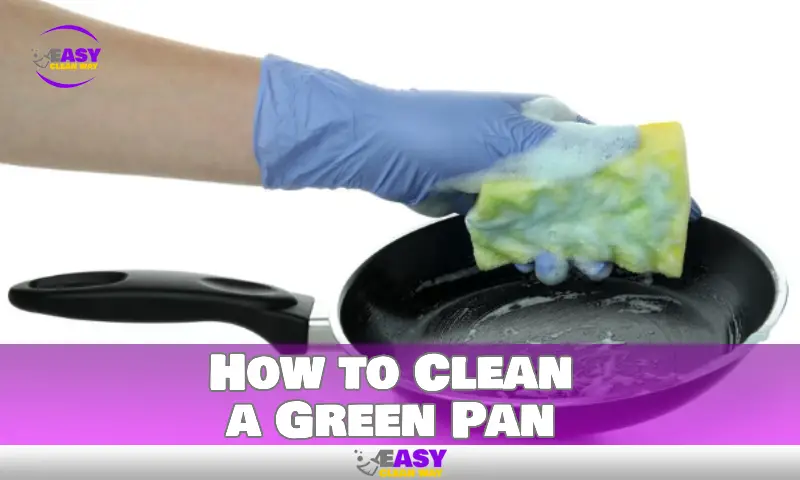To clean a reptile water dish, first empty and rinse the dish with hot water, then scrub it using a reptile-safe disinfectant. In order to maintain your pet’s health and prevent the growth of bacteria, regular cleaning of the water dish is essential.
Reptiles often defecate and shed skin in their water, making it necessary to clean the dish at least once a week. By following these steps, you can ensure that your reptile’s water dish remains clean and hygienic, providing them with a safe source of water.
The Importance Of A Clean Reptile Water Dish
Reptiles, like any pet, require a clean water dish to maintain their health and well-being. A dirty water dish can become a breeding ground for bacteria and other harmful pathogens that can make your reptile sick. Regular cleaning and maintenance of the water dish are essential to ensuring your pet’s good health.
Let’s dive deeper into why a clean reptile water dish is crucial and the potential risks of neglecting its cleanliness.
Why A Clean Reptile Water Dish Is Essential For Your Pet’S Health And Well-Being
- Prevents the growth of harmful bacteria: Leaving a water dish dirty can lead to the proliferation of bacteria, such as salmonella and E. coli. These bacteria can cause severe illness, not only in your reptile but also in humans who come into contact with contaminated surfaces.
- Provides clean and fresh water: Reptiles rely on water for hydration, just like any other living creature. A clean water dish ensures that your pet has access to fresh and uncontaminated water, promoting their overall health and well-being.
- Reduces the risk of diseases: A dirty water dish creates an environment conducive to the spread of diseases. Reptiles can contract various illnesses, such as respiratory infections and gastrointestinal issues, from drinking water contaminated with pathogens. Regular cleaning minimizes the risk of such diseases.
- Promotes good hygiene: Maintaining a clean water dish fosters good hygiene practices for both you and your reptile. It is a responsible pet owner’s duty to provide a clean and safe habitat for your pet.
How A Dirty Water Dish Can Lead To Bacterial Growth And Disease
- Contamination from fecal matter: Reptiles may defecate in their water dish, introducing harmful bacteria and parasites into the water. The presence of fecal matter creates an ideal environment for bacterial growth and increases the risk of disease transmission.
- Stagnant water: When left unchanged for an extended period, water in a reptile’s dish can become stagnant. Stagnant water lacks oxygen, making it a breeding ground for harmful bacteria and algae, further compromising your pet’s health.
- Biofilm formation: Over time, bacteria grow and form a slimy layer called biofilm on the surface of the water dish. This biofilm contains colonies of bacteria that continuously release pathogens into the water, making it unsafe for your reptile to drink.
The Benefits Of Regular Cleaning And Maintenance
Regularly cleaning your reptile’s water dish and ensuring proper maintenance has numerous benefits, including:
- Prevention of bacterial and fungal growth: Cleaning the water dish regularly eliminates any bacteria, fungi, or parasites that may have accumulated. This prevents the reptile from ingesting harmful microorganisms and helps maintain its overall health.
- Removal of debris and waste: Cleaning removes any debris and waste that may have settled at the bottom of the water dish, such as shed skin or leftover food. This ensures clean, clear water for your pet to drink.
- Fresh water supply: Regular cleaning ensures a continuous supply of fresh water for your reptile, promoting hydration and preventing dehydration-related health issues.
- Enhanced appearance: A clean water dish not only benefits your reptile’s health but also enhances the visual appeal of its habitat. A clean environment contributes to a happier and more vibrant-looking pet.
Maintaining a clean reptile water dish is crucial for the health and well-being of your pet. Regular cleaning prevents bacterial growth, reduces the risk of diseases, and promotes good hygiene. By providing your reptile with a clean and fresh water source, you help ensure its overall health and happiness.
So, make it a habit to regularly clean and maintain your reptile’s water dish for the best care possible.
Preparing For The Cleaning Process

Cleaning your reptile’s water dish is an essential part of maintaining their health and well-being. Before you begin the cleaning process, it’s important to gather the necessary supplies and take certain safety precautions. Here’s what you need to know:
Gathering The Necessary Supplies For Cleaning The Reptile Water Dish:
- Mild dish soap or reptile-safe cleaning solution
- Soft-bristled brush or sponge
- Clean, lint-free cloth or paper towels
- Access to warm water
- Gloves (optional)
- Protective eyewear (optional)
Safety Precautions To Consider Before Starting The Cleaning Process:
- Ensure that you wash your hands thoroughly with soap and water before and after handling the water dish. This helps prevent the spread of bacteria or parasites.
- If you choose to wear gloves, make sure they are clean and free of any residues or chemicals that could be harmful to your reptile.
- If you’re using a reptile-safe cleaning solution, carefully read and follow the instructions provided by the manufacturer to avoid any potential risks.
- Consider wearing protective eyewear to protect your eyes from any splashes or debris while cleaning the water dish.
- Avoid using any harsh cleaning agents, such as bleach or ammonia, as they can be toxic to reptiles. Stick to mild dish soap or reptile-safe cleaning solutions.
Removing The Water Dish From The Enclosure Safely:
- Make sure to turn off any heating or lighting elements in the enclosure to avoid accidental burns or damage to the bulbs.
- Gently grasp the water dish and remove it from the enclosure, taking care not to spill any water or disturb your reptile.
- Place the water dish on a stable surface, such as a countertop or sink, where you can comfortably clean it without the risk of dropping or breaking it.
- If the water dish is dirty or has any debris adhered to it, gently scrub the dirt away with a soft-bristled brush or sponge. Avoid using abrasive materials that could scratch or damage the dish.
- Rinse the water dish thoroughly with warm water to remove any soap or cleaning solution residue.
By following these simple steps, you can ensure that you are well-prepared for the cleaning process of your reptile’s water dish. Taking the necessary precautions and using the proper cleaning supplies will help keep your reptile healthy and happy.
Step 1: Emptying And Disposing Of The Contaminated Water
When it comes to cleaning a reptile water dish, one of the most important steps is properly emptying and disposing of the contaminated water. This not only helps maintain a clean and hygienic water dish for your reptile but also ensures their well-being.
Here are some key points to consider when emptying and disposing of the contaminated water:
- Using gloves or other protective gear: It is vital to protect yourself when handling contaminated water. Use gloves or any other appropriate protective gear to prevent any potential health risks. Safety should always be a priority.
- Environmentally-friendly ways of disposing of the water: Disposing of the contaminated water properly is not only important for your reptile’s health but also for the environment. Here are some eco-friendly methods you can consider:
- Flushing it down the drain: If the contaminated water doesn’t contain any harmful chemicals or medications, you can safely dispose of it by flushing it down the drain. Ensure that your local regulations allow this method.
- Watering outdoor plants: Recycling the water and using it to water outdoor plants can be an eco-friendly alternative. Just make sure the plants are not sensitive to any possible contaminants. Avoid using it on edible plants or sensitive species.
- Pouring it into the toilet: Another safe option for disposing of the contaminated water is pouring it into the toilet. However, avoid using this method if the water contains chemicals or medications that are harmful to the environment.
- Consider evaporation: Depending on the volume and content of the contaminated water, you can let it evaporate naturally over time. This method can be suitable if the water does not pose any immediate risk and doesn’t contain harmful substances.
Remember, the well-being of your reptile depends on maintaining a clean water dish. Properly emptying and disposing of the contaminated water is the first step towards achieving a hygienic environment for your scaly friend.
Step 2: Rinsing The Reptile Water Dish
To ensure a clean and safe environment for your reptile, it is essential to thoroughly rinse their water dish. This step will remove any debris or remaining contaminants that may be present. Here are some key points to remember when rinsing the reptile water dish:
- Use clean, non-toxic water: It’s important to use water that is free from any chemicals or contaminants. Tap water can sometimes contain chlorine or other additives, so it’s best to use filtered or bottled water for rinsing the dish.
- Reach all areas of the dish: Pay attention to all areas of the water dish, including corners and crevices. Debris and bacteria can easily accumulate in these hard-to-reach spots, so make sure to thoroughly rinse them.
- Scrub if necessary: If there are stubborn stains or residues on the water dish, gently scrubbing with a soft brush can help remove them. Avoid using harsh chemicals or abrasive materials that could damage the dish.
- Rinse thoroughly: Once you have scrubbed the dish (if needed), rinse it thoroughly with clean water. Ensure that all soap, residue, and debris are completely removed.
- Inspect for cleanliness: After rinsing, carefully inspect the water dish to ensure that it is clean and free of any remaining contaminants. Look for any visible signs of dirt or residue, and if necessary, repeat the rinsing process.
By following these tips and thoroughly rinsing the reptile water dish, you can provide your reptile with a clean and hygienic drinking source. Remember to maintain a regular cleaning routine to ensure their health and well-being.
Step 3: Scrubbing And Removing Stubborn Stains
Cleaning your reptile’s water dish is crucial for maintaining their health and providing them with fresh water. However, it is essential to use the right cleaning solution to ensure that you do not harm your pet. Here are some key points to consider:
- Avoid using harsh chemicals: Harsh chemicals can be toxic to reptiles, so it is best to stay away from them. Opt for more natural and reptile-safe cleaning solutions.
- Use white vinegar: White vinegar is a safe and effective option for cleaning reptile water dishes. It is a natural disinfectant that can help remove stubborn stains and kill bacteria.
- Dilute the vinegar: To ensure your reptile’s safety, dilute the vinegar with water before using it to clean the water dish. A mixture of equal parts vinegar and water should be sufficient.
- Rinse thoroughly: After using the vinegar solution, make sure to rinse the water dish thoroughly with water. This will remove any residue and eliminate the vinegar smell.
Techniques For Effectively Scrubbing Away Stubborn Stains And Residue
Stubborn stains and residue can be a challenge to remove from reptile water dishes. However, with the right techniques, you can effectively clean them. Consider the following:
- Soak in vinegar solution: For stubborn stains and residue, soak the water dish in the diluted vinegar solution for about 15-20 minutes. This will help loosen the stains and make them easier to scrub off.
- Use a soft brush or sponge: Avoid using abrasive materials that can scratch the surface of the water dish. Opt for a soft brush or sponge to gently scrub away the stains and residue.
- Apply gentle pressure: Apply gentle pressure while scrubbing to avoid damaging the water dish. If the stains are particularly tough, you can repeat the soaking and scrubbing process until they are completely removed.
- Rinse thoroughly: Once you have scrubbed away the stains, rinse the water dish thoroughly to remove any remaining residue or cleaning solution.
How To Avoid Using Harsh Chemicals That May Be Harmful To Your Reptile
When it comes to cleaning your reptile’s water dish, it is crucial to avoid using harsh chemicals that can be harmful to your pet. Here’s what you need to know:
- Choose natural alternatives: Opt for natural cleaning solutions like vinegar, which is safe for reptiles. Avoid using bleach, ammonia, or any other chemicals that can be toxic to your pet.
- Read labels carefully: Before purchasing any cleaning products, read the labels carefully to ensure they are safe for reptiles. Look for natural, non-toxic, and reptile-specific options.
- Make your own cleaning solution: If you prefer, you can make your own cleaning solution using natural ingredients like vinegar and water. This way, you have complete control over what goes into it.
- Consult a reptile expert: If you’re unsure about which cleaning products are safe for your reptile, consult a reptile expert or veterinarian. They can provide you with accurate information and recommendations specific to your pet’s needs.
Remember, regularly cleaning your reptile’s water dish is essential for their well-being. By following these steps and using safe cleaning solutions, you can ensure that your reptile stays healthy and hydrated.
Step 4: Sanitizing The Reptile Water Dish
Maintaining the cleanliness of your reptile’s water dish is of utmost importance in promoting their overall health and well-being. By regularly sanitizing the water dish, you can effectively eliminate harmful bacteria and other germs that may compromise your pet’s health.
Here are some key points to consider:
- Bacteria and germs: Reptiles are susceptible to various bacteria and germs that can thrive in their water dish. These microorganisms can lead to infections and diseases if not properly addressed.
- Preventing cross-contamination: Regularly sanitizing the water dish helps prevent cross-contamination between reptiles. This is especially crucial if you have multiple reptiles living together in the same enclosure.
- Promoting hydration: A clean water dish encourages reptiles to drink, ensuring proper hydration, which is essential for their overall health and bodily functions.
- Odor control: Sanitizing the water dish helps to control unpleasant odors that can arise from stagnant water or bacterial growth.
Methods For Sanitizing Based On The Material Of The Dish (Glass, Plastic, Ceramic, Etc.)
Different materials require specific cleaning methods to effectively sanitize the water dish. Here’s a breakdown of the recommended cleaning methods for various dish materials:
Glass dishes: Glass water dishes can be easily cleaned by following these steps:
- Use warm soapy water to clean the dish, making sure to remove any leftover debris or residue.
- Rinse the dish thoroughly with clean water to remove any soap residue.
- Submerge the dish in a diluted bleach solution (1 part bleach to 10 parts water) for about 10 minutes.
- Rinse the dish thoroughly with clean water to ensure all bleach is removed before refilling with fresh water.
Plastic dishes: Cleaning plastic water dishes requires a slightly different approach:
- Start by removing any leftover food particles or debris from the dish.
- Wash the dish with warm, soapy water, using a sponge or brush to scrub away any stains.
- Rinse the dish thoroughly with clean water to remove any soap residue.
- Soak the dish in a mixture of white vinegar and water (1 part vinegar to 1 part water) for about 15 minutes to disinfect.
- Rinse the dish thoroughly with clean water before refilling it with fresh water.
Ceramic dishes: Cleaning ceramic water dishes involves the following steps:
- Remove any loose debris or food particles from the dish.
- Wash the dish with warm, soapy water, using a sponge or brush to gently scrub away any stains.
- Rinse the dish thoroughly with clean water to ensure all soap residue is removed.
- Sanitize the dish by placing it in a dishwasher or submerging it in boiling water for a few minutes.
- Allow the dish to cool before refilling it with fresh water.
Common Sanitizing Solutions And Their Appropriate Usage
There are several commonly used sanitizing solutions that can effectively eliminate bacteria and germs from reptile water dishes. Here’s a breakdown of these solutions and their appropriate usage:
- Bleach solution: A diluted bleach solution (1 part bleach to 10 parts water) is an effective way to sanitize reptile water dishes. However, it’s important to ensure that all bleach is thoroughly rinsed off before refilling the dish with fresh water to prevent any harm to your reptile.
- White vinegar: A mixture of white vinegar and water (1 part vinegar to 1 part water) can be used for disinfecting reptile water dishes. It helps eliminate bacteria and neutralize odors. After sanitizing with vinegar, rinse the dish thoroughly with clean water.
- Commercial reptile disinfectants: There are specific reptile-friendly disinfectants available on the market that are formulated to sanitize reptile water dishes effectively. Always follow the manufacturer’s instructions for proper usage and dilution ratios.
- Boiling water: Boiling water can be used to sanitize certain dish materials, like ceramic. Simply submerge the dish in boiling water for a few minutes, then allow it to cool before refilling with fresh water.
Always thoroughly rinse the water dish with clean water after sanitizing to ensure the complete removal of any cleaning solution. Regularly cleaning and sanitizing the reptile water dish will go a long way toward keeping your pet healthy and thriving.
Drying And Replacing The Reptile Water Dish

Properly drying your reptile’s water dish is crucial to preventing the growth of mold and bacteria. Here are some key points to keep in mind:
- After cleaning the water dish, ensure that it is thoroughly dried before refilling it.
- Use a clean cloth or paper towel to remove excess moisture from the dish.
- Alternatively, you can air-dry the dish in a well-ventilated area.
- Avoid using towels or rags that may contain harmful chemicals or detergents.
- Exposing the water dish to direct sunlight can also help kill any remaining bacteria or mold.
When To Replace A Reptile Water Dish And Signs Of Wear Or Damage To Look Out For:
Over time, reptile water dishes may wear out or become damaged, compromising the health and safety of your reptile. Here are some signs to look out for and when you should consider replacing the water dish:
- Cracks or chips: Inspect the water dish regularly for cracks or chips, as they can harbor bacteria or make it difficult to clean effectively. If you notice any damage, it’s best to replace the dish.
- Stains or discoloration: Persistent stains or discoloration that cannot be removed through regular cleaning may indicate a buildup of bacteria or algae. Consider replacing the water dish if you are unable to restore its cleanliness.
- Warping or deformation: If the water dish has become misshapen or warped, it may no longer hold water properly or be easy to clean. It’s advisable to replace the dish to ensure a safe and hygienic environment for your reptile.
Tips For Maintaining A Clean Water Dish Between Regular Cleanings:
While regular cleanings are essential, there are also some tips you can follow to maintain a clean reptile water dish between cleanings:
- Remove any debris: Regularly check the water dish and remove any debris, such as shed skin or food particles, to prevent the growth of bacteria or mold.
- Change water daily: Replace the water in the dish daily to ensure freshness and prevent the accumulation of harmful substances.
- Use filtered or dechlorinated water: Regular tap water may contain chemicals, such as chlorine, that can be harmful to reptiles. Consider using filtered or dechlorinated water to fill the dish.
- Avoid overcrowding: If you have multiple reptiles sharing the same enclosure, ensure that each reptile has access to a clean water dish to avoid contamination.
By following proper drying techniques, knowing when to replace a water dish, and maintaining cleanliness between regular cleanings, you can provide a safe and healthy environment for your reptile.
FAQ
How Often Should A Reptile Water Dish Be Cleaned?
It is recommended to clean the reptile water dish at least once a day to prevent bacterial growth and maintain water freshness.
What Is The Best Way To Clean A Reptile Water Dish?
To clean a reptile water dish, use mild dish soap and a soft brush or sponge. Rinse thoroughly with water afterward.
Can I Use Bleach To Clean A Reptile Water Dish?
No, using bleach to clean a reptile water dish is not recommended as it can be harmful to reptiles. Stick to mild dish soap and water.
Why Is It Important To Clean A Reptile Water Dish Regularly?
Regular cleaning of a reptile water dish ensures clean and bacteria-free water, promoting the health and well-being of your reptile.
Conclusion
Maintaining a clean reptile water dish is crucial for the health and well-being of your beloved reptile companion. Regular cleaning and disinfection help prevent the growth of harmful bacteria and keep the water fresh. Remember to remove any uneaten food or debris daily and thoroughly clean the dish at least once a week using a reptile-safe disinfectant.
Use a soft brush or sponge to scrub away any residue, ensuring all traces of dirt and grime are eliminated. Rinse the dish thoroughly with clean water before refilling it with fresh water. By following these simple steps, you can provide your reptile with a clean and safe water source, reducing the risk of illness and promoting their overall happiness.
Happy cleaning!
Hey there! I’m Alton Smith, your Clean Expert blogger. I’m on a quest to help you conquer chaos and embrace the joys of a tidy life.





